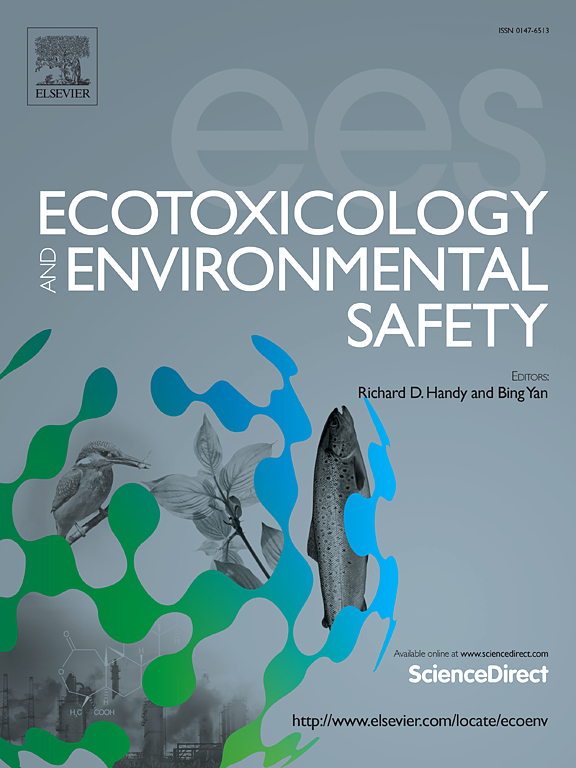Chlorantraniliprole-induced oxidative stress, DNA damage, and apoptosis in Caenorhabditis elegans: Mechanistic insights and ecological risk implications
IF 6.2
2区 环境科学与生态学
Q1 ENVIRONMENTAL SCIENCES
引用次数: 0
Abstract
Chlorantraniliprole (CAP) is one of the most widely used insecticides in the world. CAP is strictly restricted in foodstuff with maximum residual limits (MRLs) from 0.01 to 40 mg/kg set by Chinese national food safety standard. However, a detailed evaluation on its possible acute toxicity and the underlying mechanisms remains inconclusive. In this study, effects of CAP at environmentally relevant concentrations on growth, locomotion, lifespan, reproduction, and antioxidative defense systems were evaluated using the model organism Caenorhabditis elegans. Exposure to CAP notably reduced nematode development, head thrash, and pharyngeal pumping frequency compared with the control. Moreover, CAP at 0.1, 1, and 10 μg/L decreased lifespan of nematodes by 23.73 %, 28.71 %, and 36.23 %, respectively. CAP at 1 and 10 μg/L enhanced the ROS level, reduced the activity of antioxidative enzyme, including CAT and SOD. CAP also regulated mRNA expression levels of daf-16, skn-1, sod-3, gst-4, ced-3, ced-4, ced-9, egl-1, clk-2, and hus-1 in the nematodes, while no significant effect in the mutants was observed. Pearson correlation analysis revealed that significant correlation existed between tested parameters, indicating that CAP caused a series of negative effects in the nematodes. Meanwhile, molecular docking results revealed the potential of CAP to bind with oxidative stress, DNA damage and apoptosis proteins, providing molecular mechanisms for the observed detrimental effects. Therefore, our results suggested that acute exposure to CAP at environmental concentrations caused oxidative stress, DNA damage and apoptosis in the nematodes. Our results shed new light on risk assessment and management of CAP.
氯虫腈在秀丽隐杆线虫中诱导氧化应激、DNA损伤和细胞凋亡:机制见解和生态风险影响
氯虫苯甲酰胺(CAP)是世界上使用最广泛的杀虫剂之一。中国国家食品安全标准规定,CAP 在食品中的最高残留限量(MRL)为 0.01 至 40 毫克/千克,受到严格限制。然而,对其可能的急性毒性及其潜在机制的详细评估仍无定论。本研究以模式生物秀丽隐杆线虫(Caenorhabditis elegans)为对象,评估了环境相关浓度的 CAP 对其生长、运动、寿命、繁殖和抗氧化防御系统的影响。与对照组相比,暴露于 CAP 会明显降低线虫的发育、头部甩动和咽部抽动频率。此外,0.1、1 和 10 μg/L 的 CAP 会使线虫的寿命分别缩短 23.73%、28.71% 和 36.23%。1 和 10 μg/L 的 CAP 可提高 ROS 水平,降低 CAT 和 SOD 等抗氧化酶的活性。CAP 还能调节线虫体内 daf-16、skn-1、sod-3、gst-4、ced-3、ced-4、ced-9、egl-1、clk-2 和 hus-1 的 mRNA 表达水平,而对突变体则无显著影响。皮尔逊相关分析表明,测试参数之间存在显著相关性,表明 CAP 对线虫产生了一系列负面影响。同时,分子对接结果显示 CAP 有可能与氧化应激蛋白、DNA 损伤蛋白和细胞凋亡蛋白结合,为所观察到的有害效应提供了分子机制。因此,我们的研究结果表明,线虫急性接触环境浓度的 CAP 会导致氧化应激、DNA 损伤和细胞凋亡。我们的研究结果为 CAP 的风险评估和管理提供了新的思路。
本文章由计算机程序翻译,如有差异,请以英文原文为准。
求助全文
约1分钟内获得全文
求助全文
来源期刊
CiteScore
12.10
自引率
5.90%
发文量
1234
审稿时长
88 days
期刊介绍:
Ecotoxicology and Environmental Safety is a multi-disciplinary journal that focuses on understanding the exposure and effects of environmental contamination on organisms including human health. The scope of the journal covers three main themes. The topics within these themes, indicated below, include (but are not limited to) the following: Ecotoxicology、Environmental Chemistry、Environmental Safety etc.

 求助内容:
求助内容: 应助结果提醒方式:
应助结果提醒方式:


